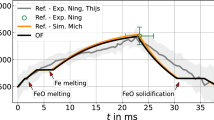Abstract
The importance of inter-particle radiation for clusters of gray and diffuse particles is investigated. The radiative cooling of each individual particle is found to vary strongly with its position in the cluster, and a “mean” radiative particle cooling term is proposed for single particle simulations of particle clusters or for high detail simulation, like Direct Numerical Simulations of small sub-volumes of large clusters of particles. Radiative cooling is shown to be important both for furnaces for coal gasification and coal combustion. Broadening the particle size distribution is found to have just a minor effect on the radiative particle cooling. This is particularly the case for large and dense particle clusters where there is essentially no effect of size distribution broadening at all. For smaller and more dilute particle clusters, the effect of distribution broadening is clear but still not dominant.



Similar content being viewed by others
Notes
In a DNS all spatial and temporal scales of the fluid are fully resolved, hence the fundamental fluid equations can be solved without any modeling of the fluid equations. This yields very accurate and reliable results, but it requires huge computational resources. With a DNS, even on the worlds largest computers, only small physical domains can therefore be considered. Note that for a typical DNS the embedded particles are assumed to be very small, and hence are not resolved. This means that even though the fluid itself can be solved without any modeling, the fluid-particle coupling must be based on models, such as e.g. the Stokesian drag law.
References
Azad FH, Modest MF (1981) Combined radiation and convection in absorbing, emitting and anisotropically scattering gas-particulate tube flow. Int J Heat Mass Transf 24:1681
Park JH, Baek SW, Kwon SJ (1998) Analysis of a gas-particle direct-contact heat exchanger with two-phase radiation effect. Numer Heat Transf A 33:701
Boutoub A, Ettouati H, Benticha H (2007) Radiative transfer effects of an axisymmetric particulate jet into a cylindrical pipe. Heat Mass Transf 43:613
Qiao L, Xu J, Sane A, Gore J (2012) Multiphysics modeling of carbon gasification processes in a well-stirred reactor with detailed gas-phase chemistry. Combust Flame 159:1693
Xu J, Qiao L (2012) Mathematical modeling of coal gasification processes in a well-stirred reactor: effects of devolatilization and moisture content. Energy Fuels 26:5759
Mitchell RE, Ma L, Kim B (2007) On the burning behavior of pulverized coal chars. Combust Flame 151:426
Hecht ES, Shaddix CR, Geier M, Molina A, Haynes BS (2012) Effect of CO2 and steam gasification reactions on the oxy-combustion of pulverized coal char. Combust Flame 159:3437
Liu XJ, Zhang WR, Park TJ (2001) Modelling coal gasification in an entrained flow gasifier. Combust Theory Model 5:595
Solomon PR, Carangelo RM, Best PE, Markham JR, Hamblen DG (1988) Twenty-first symposium (international) on combustion vol 21, 437
Siegel R, Howell JR (1992) Thermal radiation heat transfer, 3rd edn. Taylor and Francis, Washington
Booth F (1949) On the radiation from transient light sources. Proc Phys Soc A 62:95
Park S, Kim HA, Ryu C, Yang W, Kim YJ, Seo S (2012) Effects of gas and particle emissions on wall radiative heat flux in oxy-fuel combustion. J Mech Sci Technol 26:1633
Field MA, Gill DW, Morgan BB, Hawksley PGW (1967) Combustion of pulverized coal. The British Coal Utilization Research Association, Surrey
Erkku H (1959) D.Sc. Thesis in chemical engineering. MIT
Acknowledgments
This work forms part of the CAMPS project supported by the Research Council of Norway (215707). The work has additionally been produced with support from the BIGCCS Centre, performed under the Norwegian research program Centres for Environment-friendly Energy Research (FME). The authors acknowledge the following partners for their contributions: Aker Solutions, ConocoPhillips, Gassco, Shell, Statoil, TOTAL, GDF SUEZ and the Research Council of Norway (193816/S60).
Author information
Authors and Affiliations
Corresponding author
Rights and permissions
About this article
Cite this article
Haugen, N.E.L., Mitchell, R.E. Modeling radiation in particle clouds: on the importance of inter-particle radiation for pulverized solid fuel combustion. Heat Mass Transfer 51, 991–999 (2015). https://doi.org/10.1007/s00231-014-1472-4
Received:
Accepted:
Published:
Issue Date:
DOI: https://doi.org/10.1007/s00231-014-1472-4




